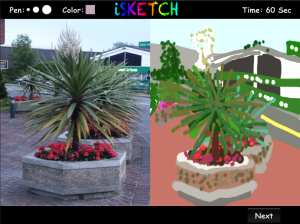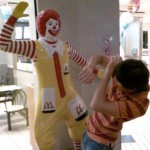 No, this post doesn’t have anything to do with the continuing conversation about violence in videogames. Rather, I wish to comment on the rising “casualty list” in undergraduate research programs. Specifically, there appears to be a rising attrition rate in my lab during the last few semesters. In general, there has been a difficulty maintaining communication with students, students have failed to meet several milestones, and students have had to withdraw from sponsored programs because participation threatens their full-time employment. Other investigators have commented on these phenomena, and so they are worth discussing.
No, this post doesn’t have anything to do with the continuing conversation about violence in videogames. Rather, I wish to comment on the rising “casualty list” in undergraduate research programs. Specifically, there appears to be a rising attrition rate in my lab during the last few semesters. In general, there has been a difficulty maintaining communication with students, students have failed to meet several milestones, and students have had to withdraw from sponsored programs because participation threatens their full-time employment. Other investigators have commented on these phenomena, and so they are worth discussing.
A.I.C. Time
I give my students a tremendous amount of freedom to encourage independence and creative problem solving. We decide upon milestones, and we have a weekly lab meeting. Apart from that structure, the students must be disciplined and communicative to meet their milestones. There has never been a problem during the first three years of the games-based learning program. Last semester, however, there was a serious issue with discipline in my lab. Of the three students who were collecting data, two failed to show up for several of their own experiments, two students failed to issue participation credit via the Research Subject’s Pool, and one student declined an opportunity to present at a national conference. All three students failed to meet major milestones, and I had to pick up a lot of the slack so they could collect data for their projects. While this problem is not necessarily endemic, conversations with other mentors lead me to believe I’m not alone here. Part of the problem, of course, exists because undergraduate researchers are learning how to work independently. Yet, there are other factors that hinder their success, particularly at urban universities. Several of my students are parents who also contribute to the income of their parents’ family as well. They have kids, a full-time job, and go to school full-time. These responsibilities limit the amount of time they have to sit and solve difficult problems. Game design and programming require extended periods of concentration analogous to writing a novel. Students need serious “ass-in-chair” time to make any headway on these problems, which is prevented by their fractured schedules. One solution to this problem would be to provide students with substantial year-round support that competes with their current wages. Some colleges have reported success in integrating undergraduate research programs with existing work-study programs. I hope to implement a program like this in the future.
Communication Let Me Down
If you are following this blog you’ll notice there is a large gap between this and my last post. One reason for that gap is that I attended a few conferences in June. The other is that my students, who were left on their own to complete a number of tasks for their projects, did not meet enough milestones to report on. Last month, a syllabus and daily communication protocol was established using a cloud-based agile development tool called TeamBox, which is a Google App that launches from the browser. TeamBox also has a free mobile app that will allow students to communicate from anywhere. While the mobile app might seem like a luxury to some, I have found that students are more likely to respond to communication on their mobile devices than in an email. All communication was moved to TeamBox so that students could (1) visualize their task list, (2) communicate their daily progress, (3) ask questions, and (4) compare their progress to that of the group. Students also had access to a Lynda.com account to learn basic programming. Finally, students were given instructions on how to install Unity, our game engine, and find the relevant tutorials. By the end of the first month, two students got as far as completing the Unity tutorials and completing online courses in programming fundamentals and object-oriented programming. Five other students abstained from the summer program either because poor communication caused them to miss the application deadline, or they couldn’t take time off from their full-time job. Another student wisely decided to take the summer off so she could care for her newborn.
Communication has been difficult with all of the students but one. I make myself available to students 24/7 via email and phone, but I limit my communication with them to business hours. While I’m always available to answer any questions they have, I don’t communicate with them apart from posting the weekly task list. Nevertheless, most students fail to respond to task lists, won’t return communication until weeks later, or fail to respond at all. In the professional world, this sort of behavior would result in some form of punishment or loss of incentives. Any psychologist/manager knows that the best way to shape a behavior is via a combination of reward and punishment. However, undergraduate research assistants are essentially volunteers. We can reward them, but there is a limit to the amount of punishment we should use. Even if you explain that their grade depends upon performance, that fact doesn’t appear to affect behavior. Punishment might also scare them away from research forever, which is an unacceptable outcome.
Implementation of a daily Scrum has been a failure. Students simply could not get in the habit of checking Teambox on a daily basis. Fortunately, the solution presented in the previous section would also address the problem of communication. If students were paid to participate in research throughout the academic year, there would be no need for maintaining communication outside of the lab. Students and mentors would be insured of quality interaction on a regular basis.
Successes
One of the goals of the lab is to broaden female and minority participation in psychology and neuroscience. Learning how to code is a large part of that mission because many tools in neuroscience require programming skills.
Two students are making great strides toward learning how to code in a game environment. Unity is not designed to teach people how to code, but there are advantages to learning object-oriented coding in Unity. First, Unity provides intuitive feedback for successes and failures. Because Unity is a 3D game engine, a programmer can see the effects of their code on the 3D world. Second, Unity practically forces programmers to develop good object-oriented practices like encapsulation, abstraction, inheritance, and polymorphism. Unity attaches little scripts to each object in the environment, which prevents students from the ill practice of developing a single “God Script” to manage the entire game. Third, Unity Script (an implementation of the Microsoft .Net framework that looks like Javascript) is very easy to learn. Memory management and garbage collection are handled automatically, and the syntax is very forgiving. Type casting and working with arrays is much easier than in C#, which is also available in Unity.
Another success in our lab has nothing to do with game-based learning but everything to do with including women in programing. Four female high school students entered my lab in the summer with a strong interest in neuroscience. I have previously resisted involving high school students in my fMRI research because there is a high barrier to entry. Students must be fluent programmers in Matlab to be of use to the lab. However, this summer, I decided to develop a project to specifically expose high school students to fMRI research. The students will learn how to navigate open-source software tools for MRI data analysis and write about their experience. They will install the tools themselves, learn how to use them, access a public MR image database, and attempt to generate a novel research hypothesis. Given the project duration, it is not likely that we will complete a full project. However, the students will document their experience along the way, and that data will be used to improve the program for future students.
So, There is a War
Engaging students in game-based learning and undergraduate research is war after all. We are fighting outdated pedagogy, poor communication, demands on student time, and ill conceived funding structures. For students to succeed in this endeavor, they need to be well armed with faculty support, time, and funding. I’m convinced that capitalizing upon existing work-study programs is critical for the success of undergraduate research. As the current Director of the Office of Undergraduate Research at York College, I look forward to implementing this change if the system will allow it. Game on!
 Summer research programs transpire in the blink of an eye and take an eternity to complete simultaneously. The paradox arises from the incredible challenges that must be accomplished during such a short period of time. Time moves slowly when you are solving a difficult problem, and time moves swiftly when you realize you only have a day to solve it. During the York Summer Research program, a majority of my students decided to work on projects related to neuroimaging. However, two students worked on projects related to game-based learning. I’m happy to say that they both met their goals.
Summer research programs transpire in the blink of an eye and take an eternity to complete simultaneously. The paradox arises from the incredible challenges that must be accomplished during such a short period of time. Time moves slowly when you are solving a difficult problem, and time moves swiftly when you realize you only have a day to solve it. During the York Summer Research program, a majority of my students decided to work on projects related to neuroimaging. However, two students worked on projects related to game-based learning. I’m happy to say that they both met their goals.









You must be logged in to post a comment.